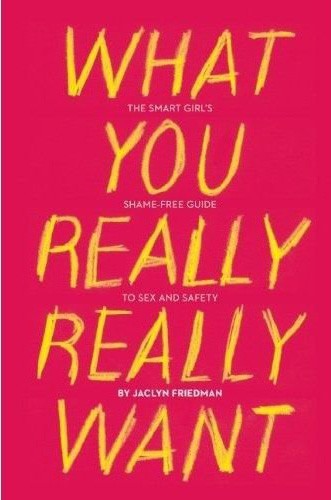
What you really really want: The smart girl’s shame-free guide to sex and safety
By Jaclyn Friedman
Seal Press, 2011
In the midst of conflicting and ubiquitous messages about women’s sexuality, it’s no wonder so many young women have a hard time determining and articulating their desires and boundaries when it comes to sex. The challenge of cultivating a healthy, satisfying, and self-directed sex life can feel next to impossible.
What You Really Really Want offers readers not only hope that a healthy sex life is possible but also practical guidance for reclaiming our sexuality. In this resolutely pragmatic, no-nonsense guide, Jaclyn Friedman expertly walks readers through the process of penetrating the layers of influence on our sexuality with the ultimate goal of taking our sex lives into our own hands.
Although written expressly for younger women and girls, the book is a valuable resource for anyone seeking to explore their sexual desires and boundaries, and is actively inclusive of all genders and sexual orientations.
Friedman is the co-editor with Jessica Valenti of the anthology Yes Means Yes! Visions of Female Sexual Power and a World Without Rape. After a reporter asked her to explain how we “figure out what we want to say ‘yes’ to in the first place,” she decided to write What You Really Really Want to help readers answer this question for themselves.
Beginning with an examination of the impact of family, media, peers, school, religious institutions, medical professionals, and partners on our sexuality, Friedman encourages readers to first determine where they currently stand when it comes to sex and sexuality before delving into what they want and, finally, how to get it.
The “terrible trio” – shame, blame, and fear – are introduced early on as major barriers to connecting with one’s sexuality. Their persistent reappearance throughout the book can feel repetitive at times, but given the pervasiveness of this “triple threat” in society and the depth of its damage, it’s hard to, well, blame Friedman for their prevalence in the book.
What You Really Really Want reads like a workbook, and Friedman encourages readers to take their time with it (a week or two per chapter, which works out to three to six months). Each chapter includes prompts for written reflection and points readers to lists of additional resources. Friedman brings in her own personal desires, boundaries, and experiences of sexuality only intermittently in order to illustrate her points. The emphasis throughout is on the reader, with Friedman guiding her along with the directness and compassion of an older sister.
Friedman’s frank yet intimate approach gives the reader a sense of being guided by competent, caring hands. The book asks a lot of its readers, challenging them to take a great deal of responsibility for their own sexual health and safety, asking them to rehash potentially painful experiences, and coaxing them through difficult but important conversations. Friedman balances this heaviness with friendly reassurances throughout, such as “This chapter may have stirred up uncomfortable memories,” and “Life is messy sometimes, and so is sex.”
The book falls short in addressing the systemic nature of sexual oppression and advocating for a society that nurtures, even celebrates, female sexuality. Friedman acknowledges that sexuality is socially constructed but only briefly touches on the structural barriers to sexual self-determination. While she guides readers through personal reflections on how systemic prejudices based on age, race, class, gender, and sexual orientation impact the way we experience sexuality as individuals, she stops short of suggesting any collective efforts to address the roots of sexual violence beyond a short section at the end that vaguely encourages us to advocate for a more “holistic, pleasure-based model” of sexual education within our schools.
Nevertheless, What You Really Really Want is a powerful tool for radically transforming how we understand and navigate the complexities of our own sexuality.






